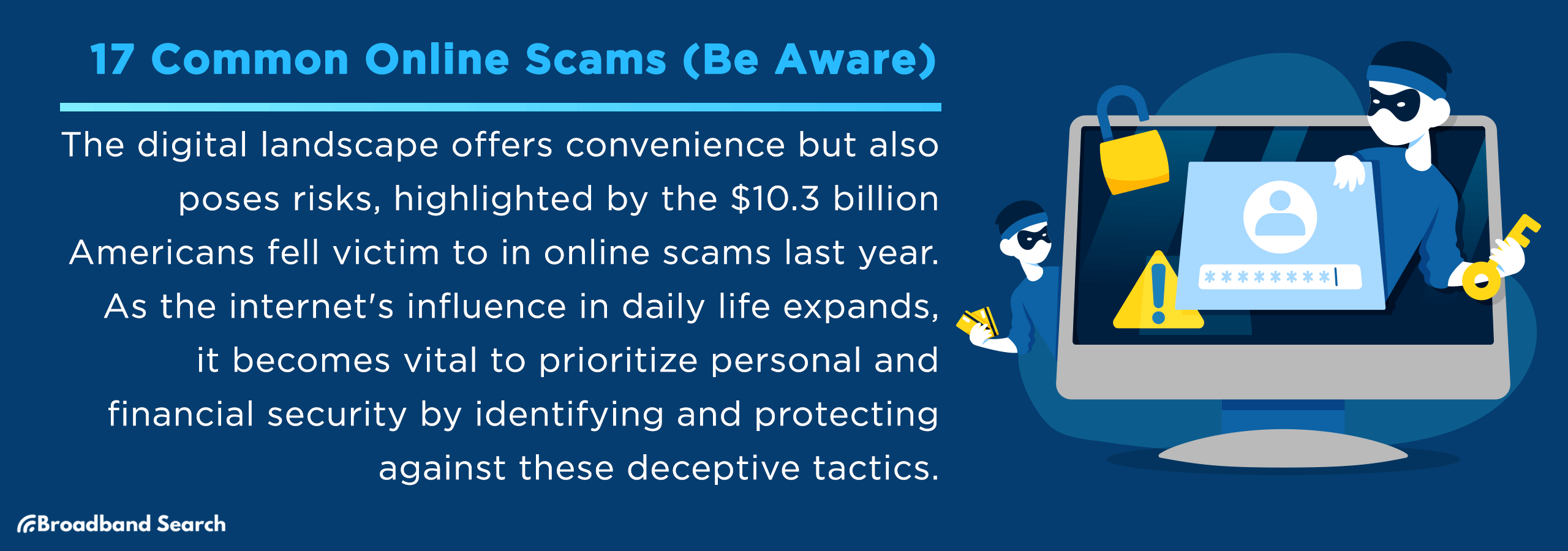The digital landscape, while offering numerous conveniences, is also riddled with threats, notably online scams. According to a recent FBI report, Americans lost a whopping $10.3 billion to various internet scams in the previous year alone. This alarming statistic showcases the increasing sophistication and prevalence of online scams that target individuals and businesses indiscriminately.
With the internet becoming an integral part of our daily lives, it's crucial for users to be aware of these deceptive schemes. From simple email phishing to intricate frauds, scammers employ a range of tactics to exploit unsuspecting victims. As such, it's imperative to recognize the signs of these scams and take measures to protect one's personal and financial information.
Understanding the Basics of Online Scams
An online scam can be broadly defined as a deceptive scheme or trick aimed at defrauding an individual or group of their money or personal information using the internet. These scams can take various forms, from phishing emails and fake websites to more complex frauds involving cryptocurrencies and advanced malware.
How Scammers Operate in the Digital Age
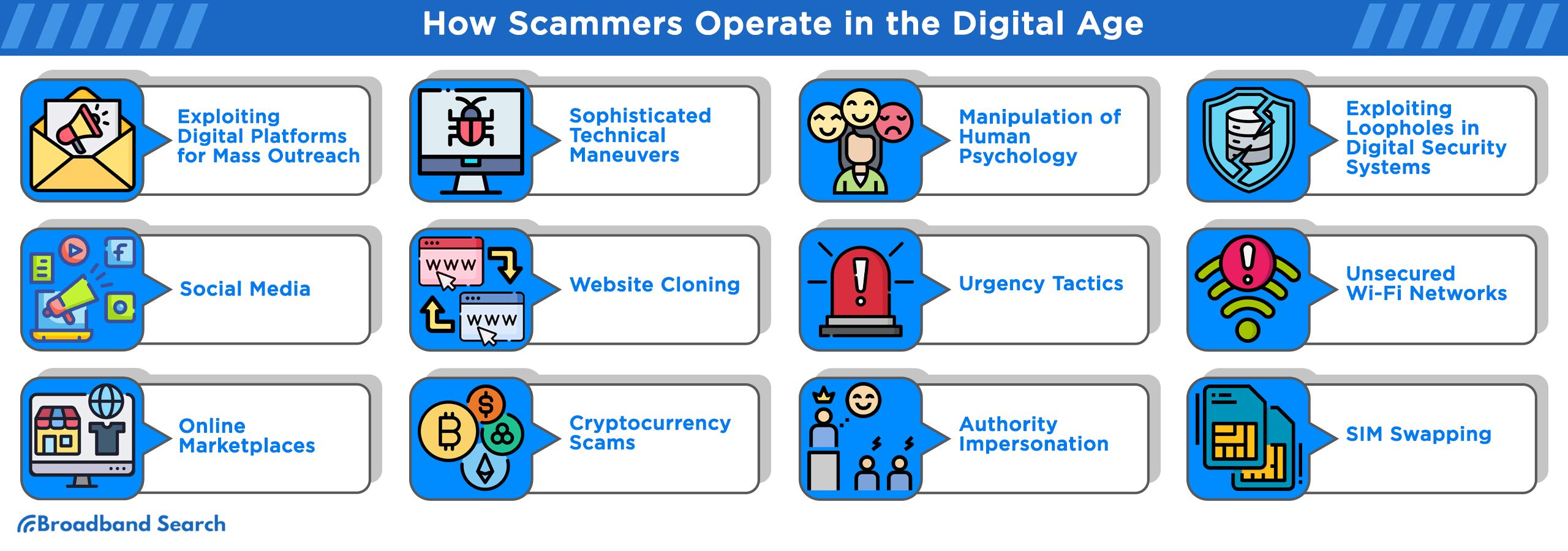
Exploiting Digital Platforms for Mass Outreach
- Email Campaigns: Scammers often send out mass emails, known as phishing campaigns, with the hope that even a small percentage of recipients will fall for the bait. These emails may contain malicious links, request personal information, or even impersonate reputable organizations.
- Social Media: With billions of users globally, social media platforms provide a fertile ground for scams. Fraudsters create fake profiles, disseminate false information, or even create scam advertisements to lure victims.
- Online Marketplaces: Sites where individuals buy and sell goods can be rife with scams. Counterfeit products, non-delivery of purchased items, and payment fraud are common tactics employed by scammers.
Sophisticated Technical Maneuvers
- Malware and Spyware: Malicious software, termed malware, and spyware are designed to secretly infiltrate a user's device. While malware often damages or disrupts the system, spyware covertly extracts sensitive data. Unsuspecting users might download these from deceptive links or infected attachments, leading to compromised security and potential data theft.
- Website Cloning: In this technique, fraudsters create replicas of genuine websites, with minor alterations. Unsuspecting users entering personal or financial details can inadvertently provide scammers with valuable data. These cloned sites look remarkably authentic, often misleading even vigilant users.
- Cryptocurrency Scams: The digital currency boom has also seen a rise in related scams. Fraudsters create sham cryptocurrency exchanges, or investment opportunities, luring victims with promises of unrealistic returns. Some even operate Ponzi schemes, paying returns to earlier investors using the capital of newer ones.
Manipulation of Human Psychology
- Preying on Emotions: Scammers masterfully manipulate emotions like fear, compassion, or greed. By crafting stories inducing sympathy or by creating fake emergencies, they coax individuals into either sending money or revealing sensitive information, often preying on the victim's innate desire to help or secure themselves.
- Urgency Tactics: Scammers create artificial deadlines or emphasize limited-time offers. This sense of urgency is a ploy to rush individuals into making decisions without proper thought or verification, thereby making them more susceptible to deceit.
- Authority Impersonation: By impersonating figures of authority such as government agents, bank officials, or law enforcement, scammers leverage the inherent trust people place in such positions. Victims, believing they're interacting with legitimate representatives, might comply with requests for money or personal data.
Exploiting Loopholes in Digital Security Systems
- Data Breaches: Large organizations often store vast amounts of user data. Cybercriminals target these databases, aiming to extract this information. Once accessed, this data can be sold on the dark web or used for identity theft, fraudulent transactions, and other malicious purposes.
- Unsecured Wi-Fi Networks: Many public Wi-Fi networks lack robust security protocols. Scammers can easily exploit these networks, intercepting data transmitted by connected users. Moreover, they can introduce malware into devices, paving the way for further exploitation.
- SIM Swapping: This sophisticated scam involves fraudsters duping mobile carriers into transferring a victim's phone number to a new SIM card, which the scammer controls. With access to one's number, they can bypass security measures like two-factor authentication, gaining control over personal accounts and sensitive data.
17 Common Online Scams
Phishing Scams
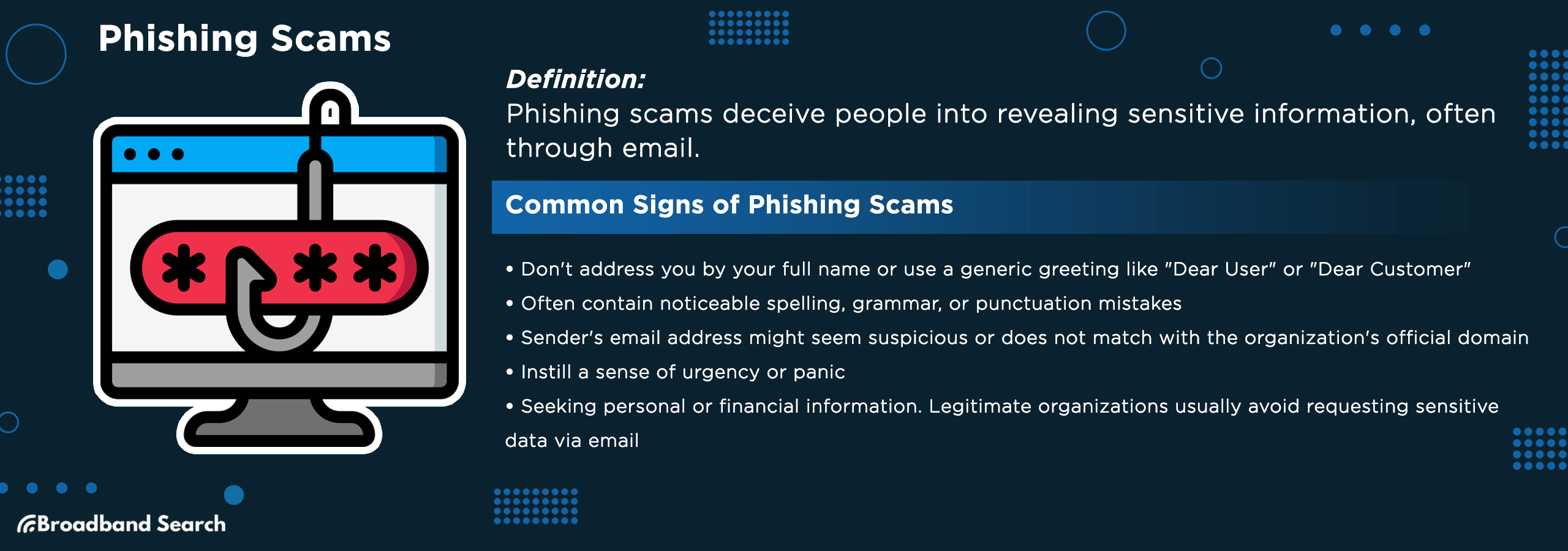
Phishing scams are deceptive tactics where fraudsters attempt to acquire sensitive information by posing as trustworthy entities, primarily via email or other online communications. These scams exploit human psychology to trick individuals into revealing their personal details, financial information, or login credentials. In 2022, about 30% of adults worldwide reported having encountered such phishing attempts, highlighting the widespread nature of this cyber threat.
Common Signs of Phishing Emails/Websites
- Unusual Greeting or Tone: Often, phishing emails don't address you by your full name or use a generic greeting like "Dear User" or "Dear Customer." The tone may feel impersonal or not match the usual communications from a known organization. It's crucial to be wary of messages that don't feel tailored to you or seem oddly formal or informal.
- Language Errors and Typos: Phishing emails can often contain noticeable spelling, grammar, or punctuation mistakes. These errors can arise because many scammers aren't native English speakers or because they rush their fraudulent campaigns. An authentic communication from a reputable organization typically undergoes thorough proofreading, making such blatant mistakes rare.
- Mismatched Email Details and Links: The sender's email address may look suspicious or not match the official domain of the organization they claim to represent. Additionally, hovering over any links in the email (without clicking) might reveal mismatched or convoluted URLs that don't lead to the official website but rather to a fake site set up to steal information.
- Alarming Alerts or Imposed Time Limits: A common tactic is to instill a sense of urgency or panic. The email might claim there's a security breach, an account suspension, or an unclaimed reward that requires immediate action. By pushing the recipient to act quickly, scammers hope they'll bypass usual caution and click on malicious links or provide sensitive details.
- Odd or Unexpected Requests: Be cautious of emails that request personal or financial information, especially if you weren't expecting them. Legitimate organizations typically won't ask for sensitive details through email. Any request for payment, especially through unconventional methods like gift cards, is a massive red flag and indicative of a scam attempt.
Nations Most Frequently Targeted in Global Phishing Attacks
In 2022, internet users in Vietnam faced the highest number of phishing attacks, with a notable attack rate of 17.03 percent. Macao came in a close second that year, experiencing an attack rate close to 14 percent. Meanwhile, Madagascar was the third most targeted, with a rate of 12 percent.
- Vietnam - 17.03%
- Macau - 13.88%
- Madagascar - 12.04%
- Algeria - 11.05%
- Ecuador - 11.05%
- Malawi - 10.91%
- Brunei - 10.59%
- Brazil - 10.57%
- Morocco - 10.43%
- Portugal - 10.33%
Global Online Sectors Most Vulnerable to Phishing Attacks
In the last quarter of 2022, financial institutions were the primary target of phishing attacks, accounting for nearly 28 percent of such incidents globally. Web-based software services and webmail were also significantly targeted, making up close to 18 percent of the attacks. Meanwhile, social media platforms weren't spared, experiencing about 10 percent of the total registered phishing attempts.
- Financial Institution - 27.7%
- Saas/Webmail - 17.7%
- Social Media - 10.4%
- Logistics/Shipping - 9%
- Payment - 6%
- E-commerce/Retail - 5.6%
- Telecom - 3.1%
- Cryptocurrency - 2.3%
- Other - 18.2%
Nigerian Prince/Advance-Fee Fraud
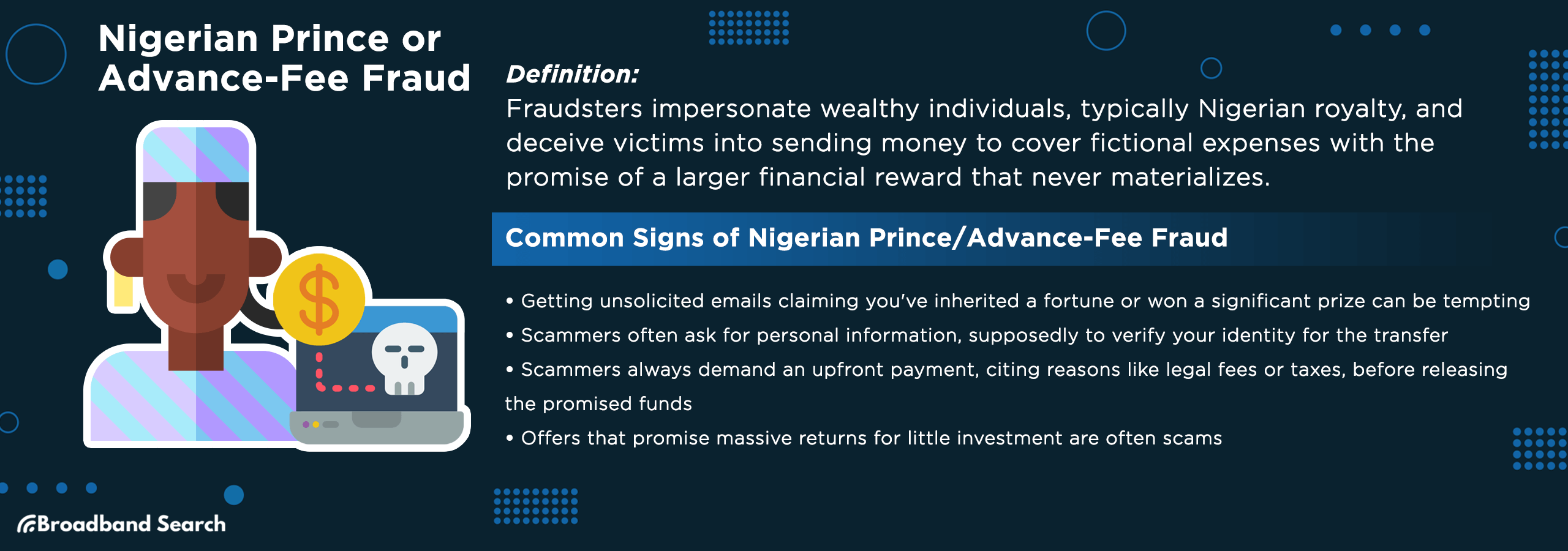
The most well-known of these cons is the Nigerian, often termed the "419" scam, named after the section of Nigerian law it breaches. While this scam has historically been disseminated through fax and standard mail, the advent of the Internet has rejuvenated its prevalence and reach. With the digital age, scammers have found more sophisticated and expansive means to target potential victims, making the need for awareness and vigilance even more crucial. These scams led Americans to lose over $703,000 just last year, underscoring their enduring and costly impact.
Tips to Identify Such Scams
- Suspicious Windfalls: Receiving unexpected emails that announce you've come into a large inheritance or have been selected as the beneficiary of a substantial amount can be enticing. However, if there's no plausible explanation for such windfalls, it's a strong indication that something is amiss. Always approach such claims with caution and skepticism.
- Requests for Personal Information: One common tactic employed by scammers is requesting personal information, purportedly to verify your identity for the money transfer. Be extremely wary of unsolicited emails that ask for sensitive details, especially if they're not from known or trusted sources.
- Advance Payment Requirement: A defining characteristic of these cons is the insistence on an upfront payment. Scammers will conjure various reasons, from legal fees to taxes, claiming these costs need to be covered before they can release the promised funds. Authentic inheritances or benefactions don't operate this way.
- Too Good to Be True: As the old adage goes, if something sounds too good to be true, it probably is. When faced with offers that promise enormous returns for minimal input or investment, it's vital to recognize this as a potential scam. Authentic opportunities rarely, if ever, promise vast rewards without significant effort or some risk involved.
Lottery and Sweepstakes Scams
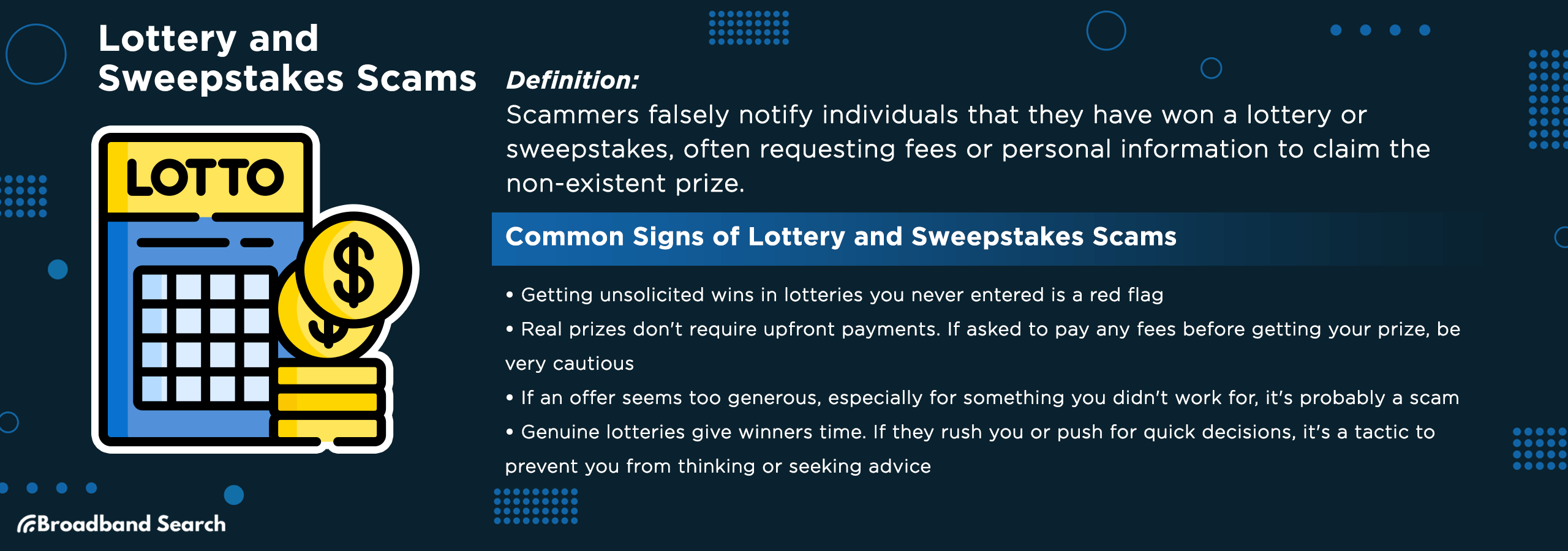
These scams trick victims into believing they've won a significant prize from a lottery or contest they didn't enter. Victims receive unexpected communications, like emails or phone calls, announcing their "win." However, before claiming the alleged prize, they're told to pay upfront fees, often masked as taxes or handling charges. In truth, there's no actual prize, and the scammers' goal is to take the victim's money. Providing personal details can also lead to further fraud or identity theft.
Red Flags to Watch Out For
- Unsolicited Notifications: Receiving sudden notifications or announcements about winning when you haven't entered any lottery or sweepstakes is a clear warning sign. Genuine lotteries don't award prizes to those who haven't participated.
- Upfront Fees: Authentic prize distributions don't ask winners to pay fees upfront. If you're told to pay any amount, whether it's termed as tax, processing, or any other fee, before receiving your prize, be highly skeptical.
- Too Good to Be True: If an offer sounds overly generous, especially if you're told you've won a large sum without any ticket purchase or effort, it's likely a scam. Always approach such offers with caution.
- Pressure to Act Quickly: Authentic sweepstakes or lotteries don't pressure winners with tight deadlines. If you're being hurried or told to make quick decisions, it's a tactic to prevent you from thinking clearly or consulting others.
Gender Differences in Scam Vulnerabilities: Sweepstake vs. Foreign Lottery Scams
- Male: A study covering 30 European nations, conducted by the European Commission in 2020, revealed comparable findings. The results indicated that individuals with higher education and income levels were more prone to report instances of fraud. Additionally, the data suggested that men were more inclined than women to state they had been defrauded.
- Female: Women were more often targeted by sweepstake scams, while men were predominantly the victims of international lottery frauds.
Yearly Trends: Changes in Average Losses and Number of Victims
In 2020, cases of lottery, sweepstakes, or inheritance scams surged to an all-time high, with approximately 8,500 victims, translating to about 23 individuals affected daily. By 2022, those who fell prey to these types of scams experienced the steepest average financial setbacks, with each victim reporting a loss of around $14.8K.
- 2022 - $14, 797, 5,650
- 2021 - $11,899, 5,991
- 2020 - $7,189, 8,501
- 2019 - $6,263, 7,767
- 2018 - $8,426,7,146
Online Shopping Fraud
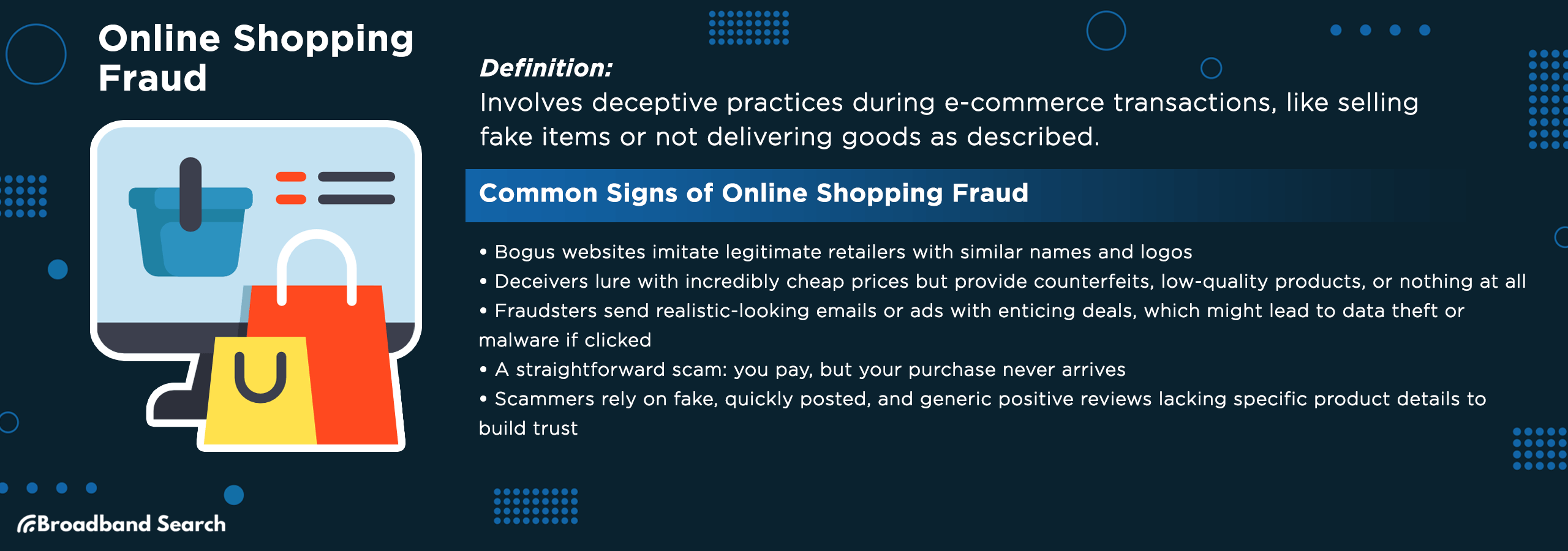
Online shopping fraud refers to deceptive practices or scams that occur during online transactions, often on e-commerce websites, auction sites, or through classified ads. This type of fraud can manifest in various ways, including selling non-existent or counterfeit items, failing to ship purchased goods, delivering products that are significantly different from their descriptions, or using fake payment platforms to steal a buyer's financial information. As online shopping gains popularity, consumers need to be vigilant and informed to protect themselves from such fraudulent activities.
Deceptive Strategies in Online Shopping Fraud
- Fake Websites: These are counterfeit sites created to mimic genuine online retailers. They may use slightly misspelled domain names or familiar logos to deceive users. While they might look legitimate, they often lack secure payment methods and might steal credit card information or sell counterfeit goods.
- Too-Good-to-Be-True Deals: Scammers often lure victims with unbelievably low prices for popular items. These deals can be enticing but often lead to counterfeit products, subpar items, or no product delivery at all.
- Phishing Emails & Fake Advertisements: Scammers send emails or display ads that appear to be from reputable sellers offering fantastic deals. Clicking on these might lead to fake websites where personal and financial information can be stolen, or they might install malware on the user's device.
- Non-Delivery of Purchased Items: One of the most straightforward scams: after making a payment, the item is never delivered. These scams often occur on fake websites or through sellers on legitimate platforms who have no intention of shipping any products.
- Fake Reviews: To gain trust, scammers might flood their products or websites with positive reviews. These reviews, however, are fabricated and don't reflect genuine customer experiences. They can be identified by generic language, rapid succession of posted reviews, or overly enthusiastic tones without specific product details.
Global E-commerce Financial Losses Due to Online Payment Fraud: 2020-2023 Overview
Based on projections, global e-commerce losses due to online payment fraud reached approximately 41 billion U.S. dollars in 2022, marking an increase from the prior year. This number is anticipated to climb to around 48 billion U.S. dollars by 2023.
- 2023 - 48 billion US dollars
- 2022 - 41 billion US dollars
- 2021 - 20 billion US dollars
- 2020 - 17.5 billion US dollars
Global Rate of Online Shopping Scam Victims Incurring Financial Losses: 2015-2022 Analysis
A recent study revealed that in 2021, 75% of global consumers who fell prey to online purchase scams incurred financial losses. Interestingly, even though there was a rise in e-commerce scams compared to the pre-pandemic levels of 2019, the proportion of online shoppers experiencing monetary losses saw a decline.
- 2022 - 71.6%
- 2021 - 74.9%
- 2020 - 78.8%
- 2019 - 81.2%
- 2018 - 75.2%
- 2017 - 72.5%
- 2016 - 74.1%
- 2015 - 71.2%
Tech Support Scams
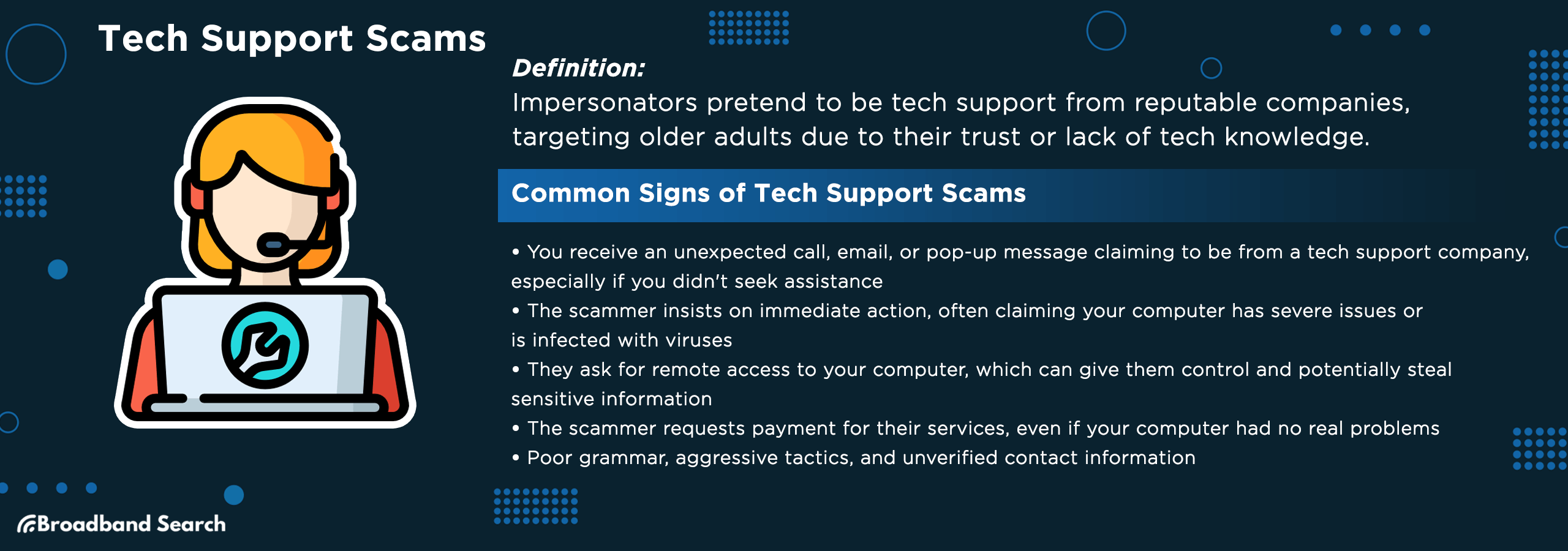
These scams involve perpetrators posing as technical support representatives from reputable companies, falsely claiming to have detected issues with a person's computer. They aim to either gain remote access to the device, install malicious software, or extort money for their "services." Notably, older adults have been the hardest hit by such scams, often due to a lack of tech-savviness or being more trusting of unsolicited communications. Reinforcing the significance of this threat, the Federal Trade Commission’s Consumer Sentinel Network recorded nearly 143,000 complaints about tech support scams in 2018 alone.
Anatomy of Tech Support Scams: Breaking Down the Deception
Diving into the intricate web of tech support scams provides a revealing snapshot of their impact on unsuspecting individuals. A staggering 59% of people have been exposed to such scams, with 41% choosing not to interact.
- Exposed to Scam - 59%
- No Interaction - 41%
- Continued - 16%
- Ignored Scam - 42%
- Lost Money to Scam - 7%
- Spent Money on Checking & Repairing - 2%
- Invested Time Checking & Repairing - 3%
- Nothing Happened - 5%
Type of Scam Interaction in US 2021
In 2021, Americans encountered various methods used by scammers to initiate deceptive interactions.
- Unsolicited Call - 37%
- Pop-up ad or Window - 43%
- Unsolicited Email - 41%
- Redirect to Website - 35%
Fake Antivirus Software
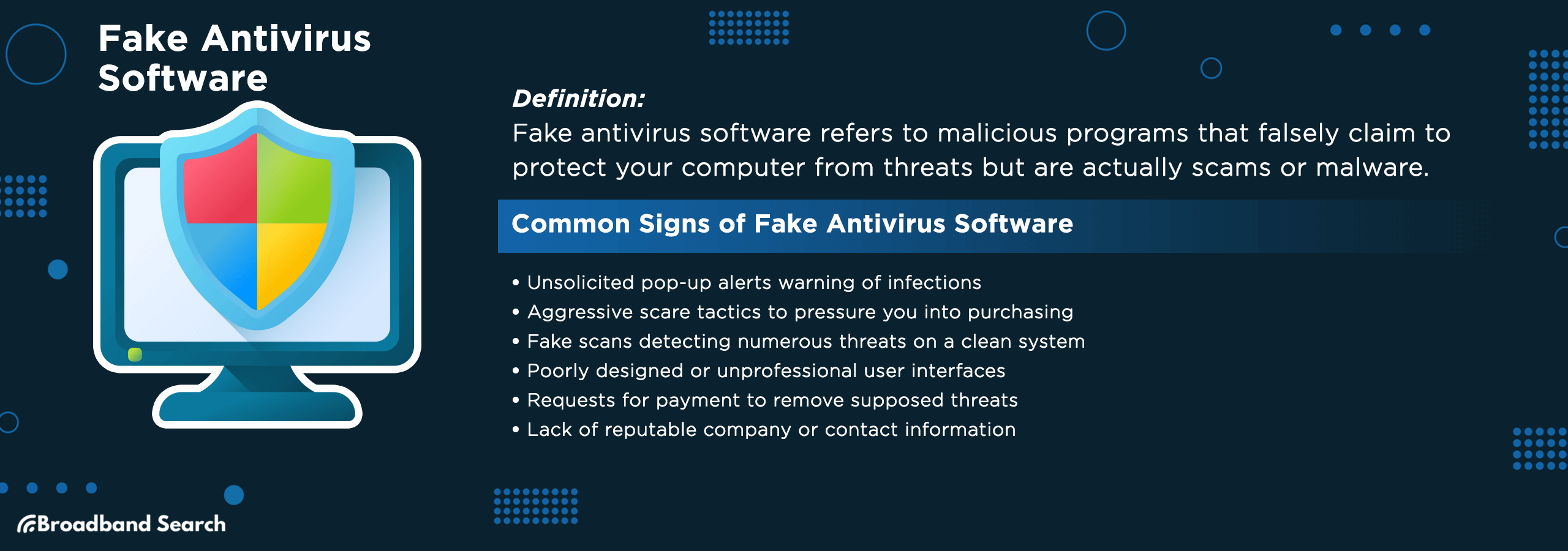
An alarming 30 million Internet users have been deceived by fake antivirus programs. These malicious software, commonly known as "rogue antivirus" or "scareware," masquerade as genuine security solutions. Users are typically bombarded with fictitious alerts about malware or virus threats, pushing them to purchase a "full version" to rectify these non-existent issues. Unfortunately, downloading or buying these programs can introduce actual malware, jeopardize personal data, or result in financial losses.
How to Differentiate Between Genuine and Fake Software
- Avoid Engaging with Alarmist Advertisements: Scare tactics are commonly used by fake software promoters. If an advertisement aggressively warns of infections or threats on your device, especially when you haven't noticed any issues, it's likely a deceptive tactic. Always approach such alarmist ads with skepticism.
- Regularly Update Your Software: Genuine software providers release regular updates to improve functionality and address vulnerabilities. Ensuring your software is consistently updated reduces the chance of fake software installations, as updates usually come directly from the original software source.
- Ensure You're Using an Authentic Antivirus Application: Only download antivirus applications from reputable sources or directly from the software company's official website. Do some research, read reviews, and perhaps even seek recommendations from tech-savvy friends or family before installing any antivirus program.
Romance and Dating Scams
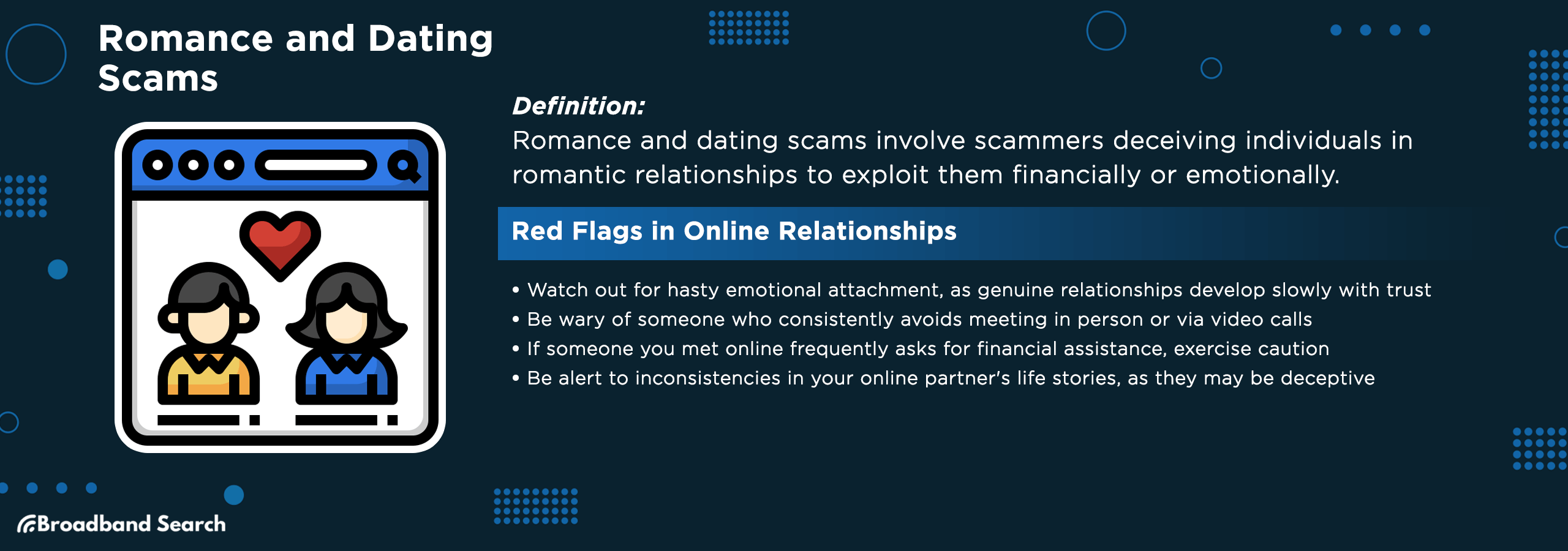
Romance scams are deceptive tactics where individuals pretend to have romantic interests to exploit victims, often for money or personal details. A staggering 70,000 individuals have fallen for such deceptions. These fraudsters masterfully manipulate emotions, using crafted stories of hardships to gain trust and sympathy. As they forge emotional connections, victims are often lured into providing financial support or sharing sensitive information, making these scams both emotionally and financially devastating.
Percentage of Adults in Chosen Countries Who Experienced Online Dating Scams
By January 2023, 66% of participants from India reported encountering an online dating scam at least once. Meanwhile, 25% of individuals in France, the United States, and New Zealand shared similar experiences. Out of all the markets studied, Japan had the lowest incidence of online dating scam encounters.
- India - 66%
- New Zealand - 25%
- United States - 25%
- France - 25%
- Australia - 22%
- Germany - 22%
- United Kingdom - 22%
- Japan - 10%
Red Flags in Online Relationships
- Rapid Intensity: If someone expresses deep feelings or talks of a serious commitment unusually quickly, it's a warning sign. Genuine relationships typically develop over time, with trust and understanding built gradually.
- Avoidance of Personal Meetings: Be wary if someone constantly comes up with excuses to avoid meeting in person or even through video calls. Genuine individuals interested in a relationship would naturally want to meet or connect more intimately.
- Frequent Financial Emergencies: A common tactic among online relationship scammers is to claim frequent financial hardships, seeking monetary assistance. If someone you've met online regularly has financial crises and asks for money, it's a red flag.
- Vague or Inconsistent Personal Details: If your online partner's stories about their life, work, family, or past seem to change or lack consistency, it could indicate deceit. Genuine individuals have no reason to provide shifting narratives about their personal details.
Investment Scams
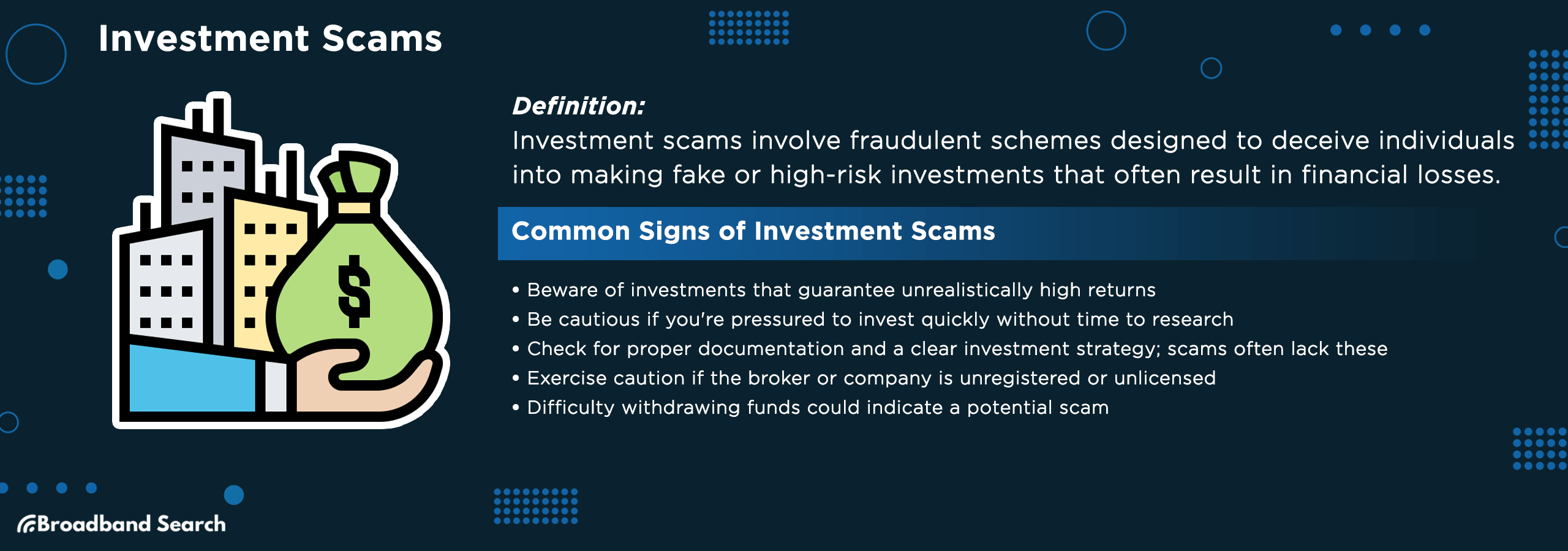
Investment scams, or investment fraud, involve tricking individuals into parting with their money by promising high returns with little to no risk. These deceptions can range from Ponzi schemes to fabricated business ventures. Scammers often use elaborate tactics to seem genuine, including counterfeit testimonials or posing as financial experts. Alarmingly, in 2022, these scams led consumers to report a staggering loss of nearly $8.8 billion.
Fluctuations in Average Losses and Number of Victims from Investment Fraud
In 2022, cases of investment fraud surged to an all-time high, affecting approximately 30,500 individuals, which translates to about 84 victims daily. That same year, those ensnared by such deceptions experienced unprecedented financial setbacks, with each victim reporting an average loss of roughly $108.5K.
- 2022 - $108,479 / 30,529
- 2021 - $70,811 / 20,561
- 2020 - $38,287 / 8,788
- 2019 - $55,560 / 3,999
- 2018 - $68,496 / 3,693
Fake Job Offers and Employment Scams
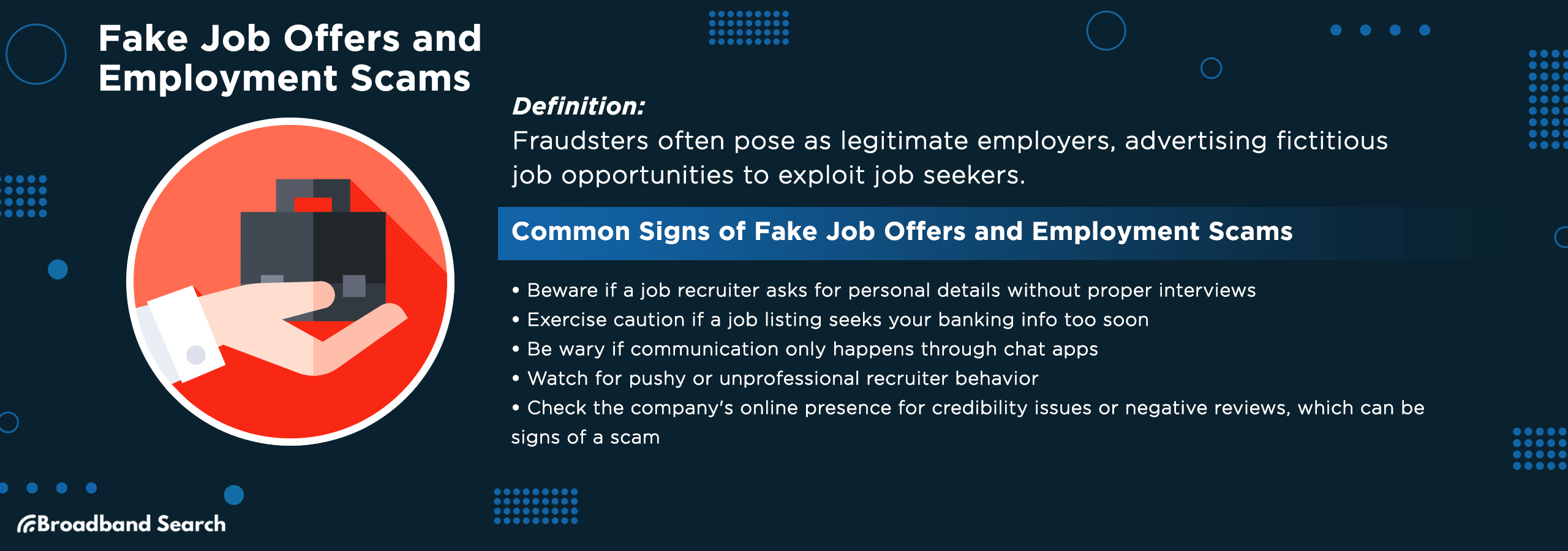
Fraudsters often pose as legitimate employers, advertising fictitious job opportunities to exploit job seekers. They might request upfront payments for supposed training or gather personal data under the pretense of application processing. Sadly, these deceptive tactics lead to substantial financial harm, with job seekers facing direct losses of around $2 billion each year due to such scams.
Common Job Scams
- Remote Work Deceptions: With the rise of remote work opportunities, scammers often advertise fake work-from-home positions, luring job seekers with the promise of flexibility and lucrative pay, only to exploit them financially or gather sensitive information.
- Fraudulent Job Proposals via Email: Unsolicited job offers arriving in your inbox should raise suspicion. These emails often contain too-good-to-be-true offers or ask for personal details, leading to potential scams.
- Bogus Job Listings on Social Platforms: Social media platforms aren't immune to job scams. Fake recruiters or employers might post enticing job listings, aiming to capture personal data or money from unsuspecting job seekers.
- Counterfeit Government and Postal Service Job Schemes: Scammers might pose as representatives from governmental or postal agencies, offering job positions in exchange for an application fee or personal details, even though most government jobs do not charge application fees.
Signs of a Fake Job Listing
- Demand for Personal Details: When a job recruiter or listing pushes excessively for your personal details without first discussing job specifics or conducting proper interviews, it's concerning. Genuine employers have structured hiring processes, and they don't typically request sensitive information without first establishing a legitimate reason or making a formal job offer.
- Immediate Request for Bank Information: Legitimate employers usually discuss banking details during the final hiring steps, primarily for salary disbursement. If a job listing demands your banking information prematurely, especially without any job confirmation or formal contract, it's a glaring warning. It could be a ploy to gain unauthorized access to your funds or commit identity theft.
- Exclusive Chat App Communication: Authentic recruiters and employers use official communication channels like company emails. If all interactions are constrained to chat apps, without any formal correspondence or phone interviews, it's suspicious. Scammers often use chat apps to remain anonymous and avoid detection.
- Unsettling Recruiter Behavior: Always trust your gut feelings. If a recruiter behaves in a manner that's pushy, evasive, or just doesn't seem right, it may indicate deception. Authentic recruiters maintain a level of professionalism, transparency, and are keen on providing clear information about the job role and company.
- Online Credibility Issues: Before engaging deeply with a job offer, always research the company's online presence. A company with little to no online footprint, negative reviews, or one that's not listed on official job platforms can be a sign of a scam. Genuine companies invest in their online reputation and are usually verifiable through multiple trustworthy sources.
Rental and Real Estate Scams
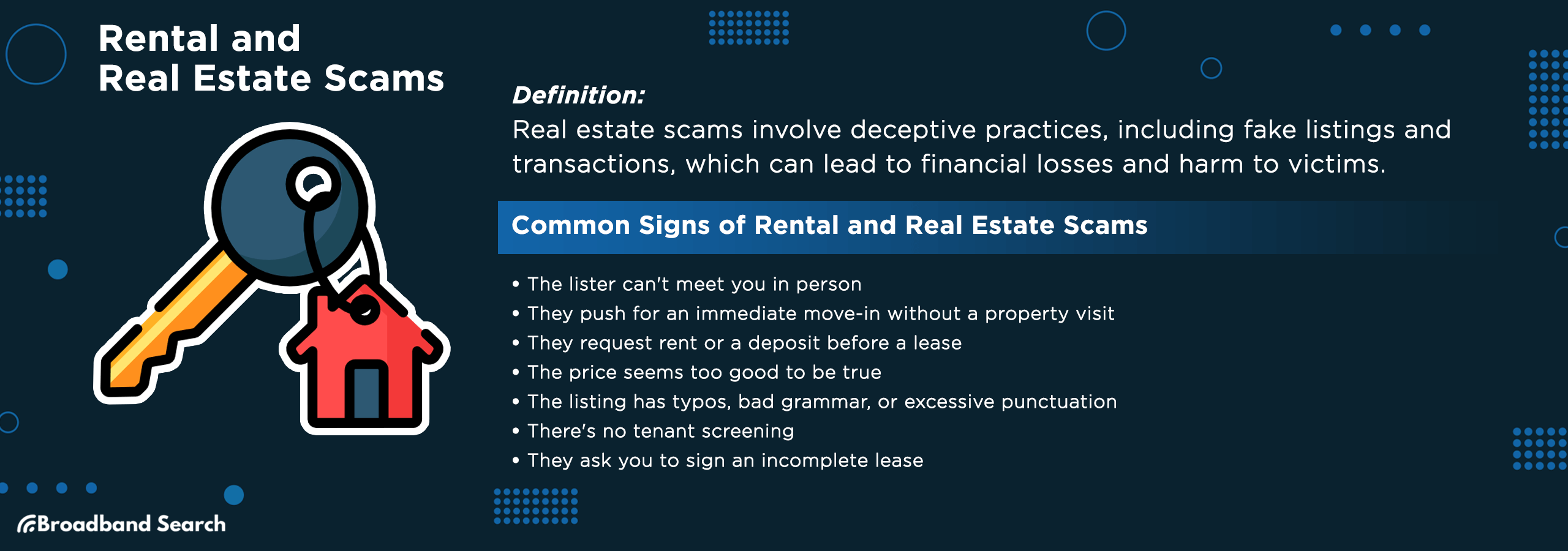
Scammers, posing as landlords or property agents, deceive individuals looking to rent or buy properties. They often list non-existent or properties they don't own at attractive rates, using genuine photos to create fake listings. Victims are usually enticed to pay upfront fees or share personal data. In 2021, these scams saw a significant spike, with 11,578 people reporting losses totaling $350,328,166, a 64% increase from the previous year.
Boston Division's Financial Impact of Fraud
The Boston Division, which encompasses several states, has seen a significant financial toll due to fraudulent activities. A breakdown of the impact in each state is as follows:
- Maine: 42 victims reported losses, amounting to $489,309.
- Massachusetts: The impact was notably higher here, with 290 victims suffering losses totaling $8,944,041.
- New Hampshire: 41 individuals fell prey to scams, incurring a combined loss of $2,576,210.
- Rhode Island: The state saw 42 victims who collectively lost $1,414,709.
IRS and Tax Scams
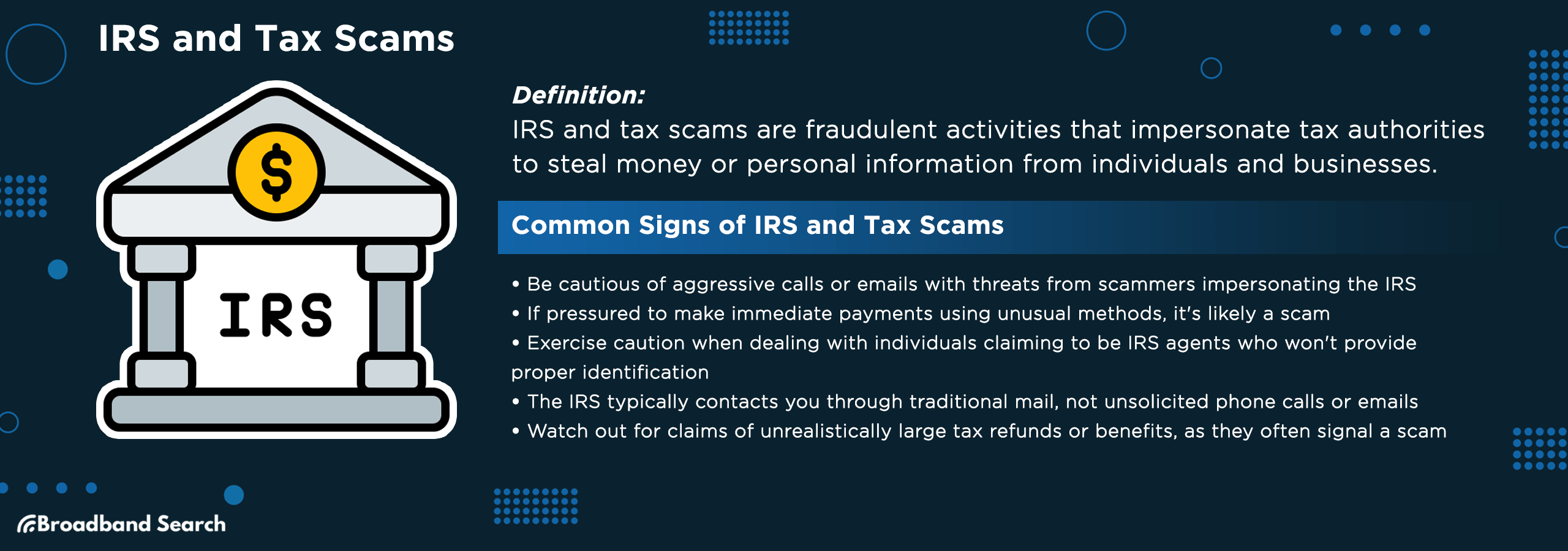
Scammers impersonating the IRS or tax entities trick individuals into believing they owe money or are entitled to large refunds, aiming to extract funds or steal personal information. The IRS, combatting this menace, has undertaken over 2,550 investigations and boasts a 90% conviction rate. Despite these efforts, such scams persist, emphasizing the need for public vigilance.
What to Do if Contacted by a Fake IRS Representative
- Do Not Engage: When you receive a call or message from someone claiming to be an IRS representative, especially if it's unexpected, be cautious. It's crucial to avoid providing any personal, financial, or other sensitive details. Scammers are adept at using this information maliciously, so always be skeptical of unsolicited requests for information.
- Verify Directly with the IRS: Instead of taking the caller's word at face value, it's best to independently verify their claims. Hang up without giving away any information, and then contact the IRS directly using their official contact details. This approach ensures you're speaking with a genuine representative and not a scammer.
- Report the Incident: Reporting suspicious calls can play a pivotal role in curtailing such fraudulent activities. By notifying the Treasury Inspector General for Tax Administration (TIGTA), you're not only protecting yourself but also helping authorities identify and track down these deceitful individuals, thereby preventing potential scams against others.
- Stay Informed: Awareness is one of the most effective tools against scams. By staying updated on the IRS's official communication methods and procedures, you can easily distinguish between legitimate IRS communications and deceitful attempts. Familiarize yourself with common scam tactics and regularly check the IRS website for updates and alerts.
Social Media Scams
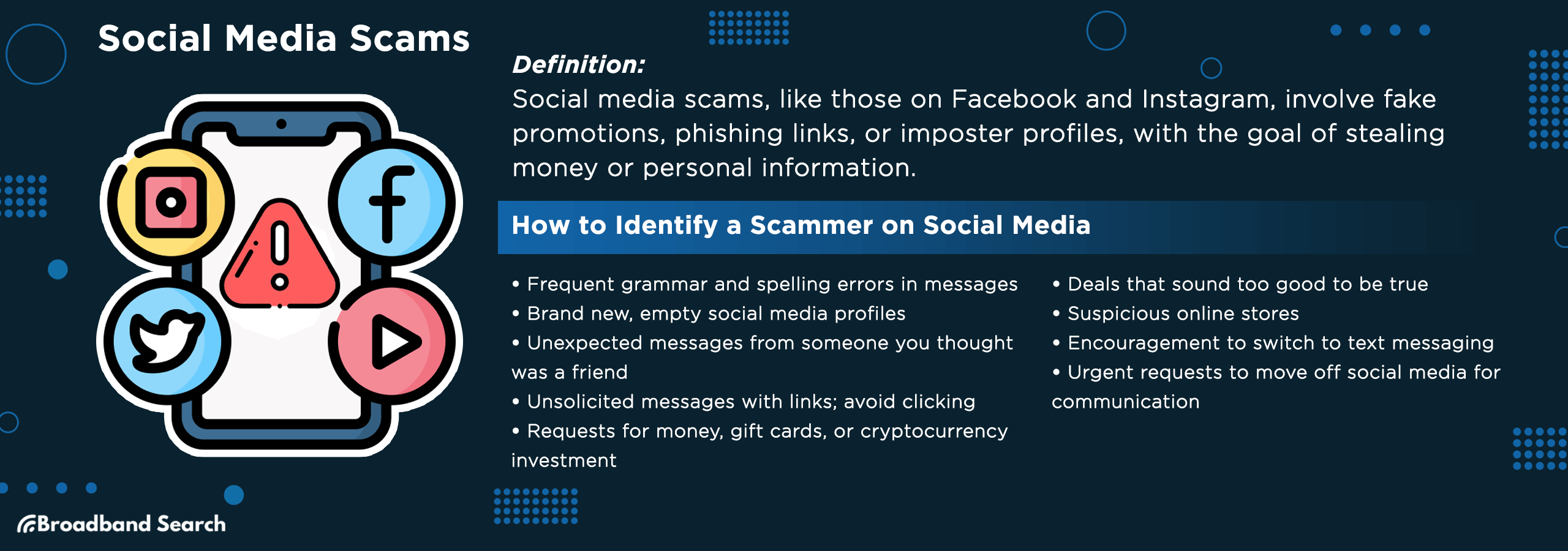
Social media scams are deceptive tactics on platforms like Facebook and Instagram, where fraudsters exploit users through fake promotions, phishing links, or imposter profiles. These schemes aim to steal money or personal details. In 2021, these scams affected over 95,000 people, leading to losses of about $770 million. The trust and vast user base on social media make it a prime target for such frauds, emphasizing the need for user caution.
Social Media Fraud Soared Over Five Years
Numbers are derived from fraud reports submitted directly to the FTC that highlight financial losses and specify social media as the point of contact.
- 2021 - $770M
- 2020 - $258M
- 2019 - $105M
- 2018 - $78M
- 2017 - $42M
Weekly Scam Encounters by Social Media Users
As social media platforms continue to dominate our daily interactions, they unfortunately also become breeding grounds for scams. A recent analysis sheds light on the frequency with which users encounter scams on various platforms on a weekly basis.
- Facebook - 62%
- TikTok - 60%
- Whatsapp - 57%
- Instagram - 56%
- Twitter - 53%
- LinkedIn - 31%
Bitcoin and Cryptocurrency Scams
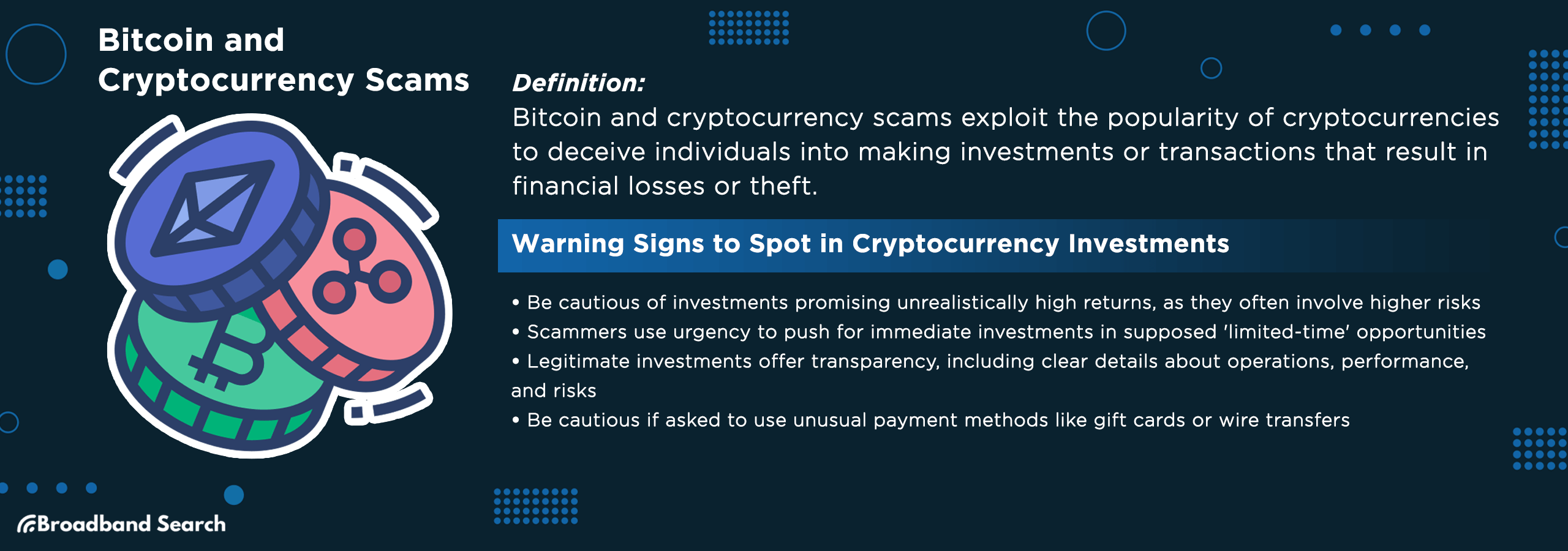
Cryptocurrency scams deceive investors and users of digital currencies like Bitcoin. With the allure of high returns and the surge in Decentralized Finance (DeFi) platforms, scammers have found more avenues to exploit. In 2021, these fraudulent activities led to a staggering global loss of $14 billion in cryptocurrency, highlighting the importance of caution in the crypto realm.
Warning Signs to Spot in Cryptocurrency Investments
- Guaranteed High Returns: Any investment promising consistent and unusually high returns, especially in the volatile world of cryptocurrency, should be approached with skepticism. It's essential to remember that with higher returns come higher risks.
- Pressure to Act Now: Scammers often create a sense of urgency, urging you to invest immediately to avoid missing out on a "limited-time" opportunity. Genuine investments rarely come with such pressure tactics.
- Lack of Transparency: A legitimate investment will always provide clear details about its operations, past performance, and potential risks. If the information is vague, hidden, or not easily accessible, it's a red flag.
- Unusual Payment Methods: Be wary if you're asked to make payments through unconventional methods, such as gift cards or wire transfers. Legitimate crypto investments typically use standard payment and transfer methods within established cryptocurrency platforms.
Top Crypto Projects Stealing from Their Investors
The cryptocurrency space, while promising, has also been riddled with scams and dubious projects that have swindled investors out of billions. These deceptive schemes, often referred to as "rug pulls," involve projects that collect funds and then disappear or manipulate the market against their investors. Here's a rundown of some of the most notorious crypto projects based on the estimated USD value stolen
- OneCoin - +$4,000M
- Thodex - $2,600M
- AnubisDAO - $58M
- Uranium France - $50M
- DeFi100 - $32M
- Meerkat Finance - $31M
- Snowdog DAO - $30M
- StableMagnet - $22M
Charity Scams
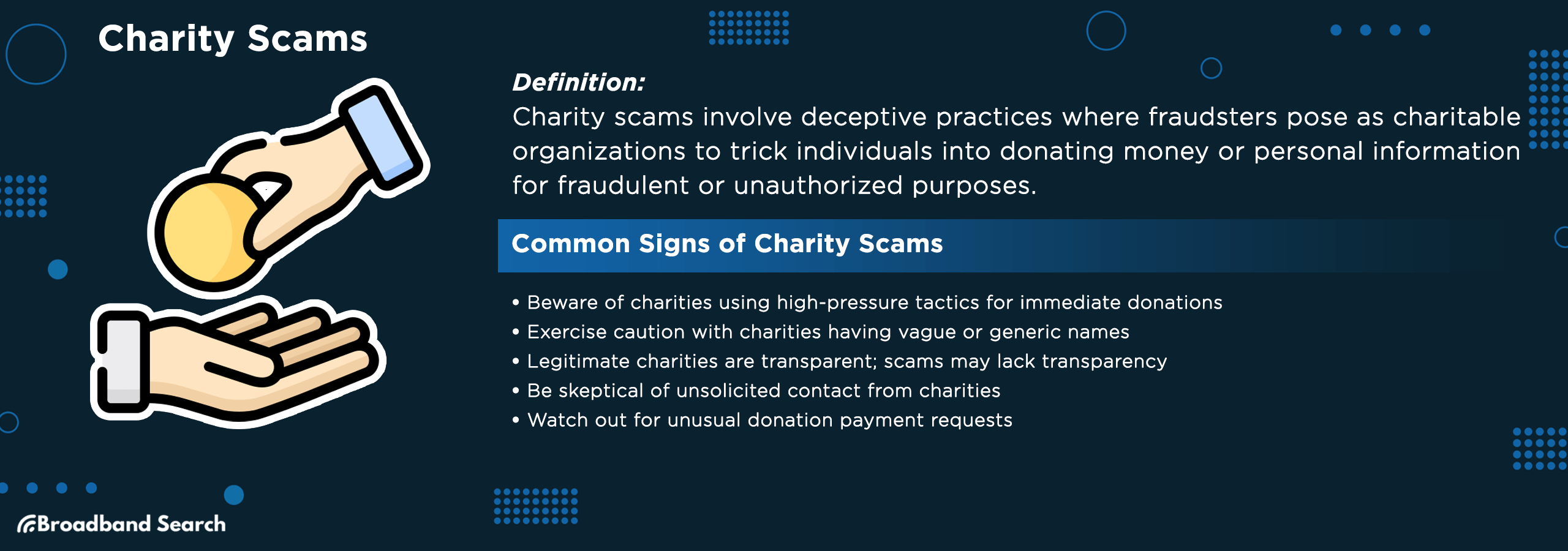
Charity scams exploit individuals' generosity during times of crises or significant events. Fraudsters create fake charities, mimicking legitimate ones, to trick people into donating. They capitalize on emotional events, ensuring funds go to them instead of genuine causes. In 2020, charity scams saw a concerning 70% spike, as reported by Scams Awareness Week, highlighting the need for thorough verification before donating.
Verifying Legitimate Charities
- Check Registration and Licensing: Ensure the charity is registered and licensed with relevant local or national regulatory bodies. A genuine charity will have official credentials and documentation that validate its legitimacy.
- Research Online Platforms: Utilize online platforms like Charity Navigator or the Better Business Bureau to read reviews and ratings. These platforms provide insights into the charity's operations, efficiency, and transparency.
- Review Financial Statements: A legitimate charity will have its financial statements and annual reports accessible to the public. Scrutinizing these documents can offer insights into how the charity utilizes its funds and its allocation towards the cause versus administrative costs.
- Contact Directly: Engage with the charity directly, either through a phone call or a visit. Direct interactions can provide clarity on their activities, projects, and can also be a way to gauge their authenticity. Genuine charities will be transparent and open to inquiries.
Ticket Scams
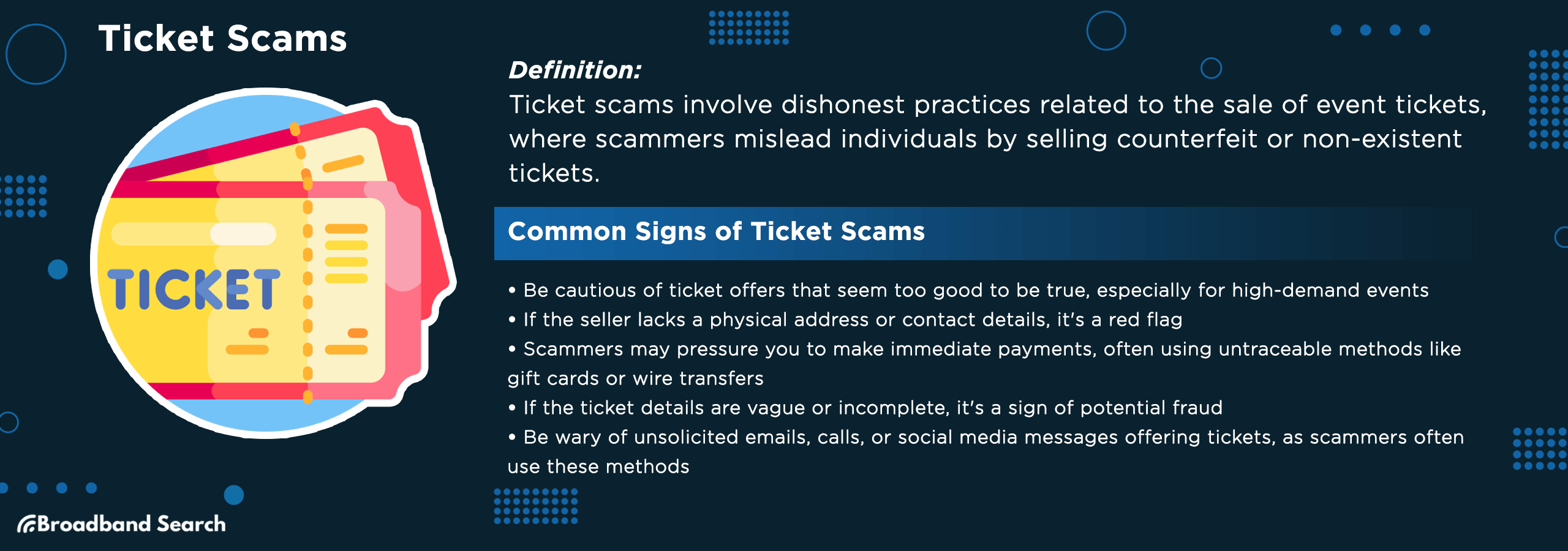
With a 110% rise in concert ticket demand, ticket scams have also surged. Experts from VPNOverview have highlighted the growth of resale ticket frauds, where counterfeit tickets are sold or one ticket is sold to many. Awareness and vigilance are crucial to avoid such scams and ensure genuine purchases.
Shielding Yourself from Ticket Scammers: Key Precautions to Take
- Approach with Caution: Exercise skepticism towards ticket offers that appear unusually cheap or too favorable, especially for events with high demand. Scammers exploit the allure of great deals to trap unsuspecting buyers.
- Buy from Trusted Individuals: Prioritize purchasing tickets from known sources or individuals. Personal acquaintances, like family members, close friends, or coworkers, are often more reliable than anonymous online sellers, reducing the risk of scams.
- Avoid Peer-to-Peer Payment Services: While platforms like Zelle, Venmo, and CashApp are convenient, they often lack robust consumer protection mechanisms. When buying tickets, especially from unknown sources, opt for methods with better security, like credit cards.
- Verify Seat Authenticity: Before committing to a purchase, cross-reference the ticket's seat and section details with the venue's official seating chart. Ensure the offered seating aligns with the venue's layout to avoid potential scams.
- Ensure Genuine Websites: When seeking tickets from renowned platforms such as Ticketmaster or StubHub, meticulously verify the website's URL. Scammers often create look-alike sites to deceive buyers, so always ensure you're on the legitimate platform.
Gift Card Scams
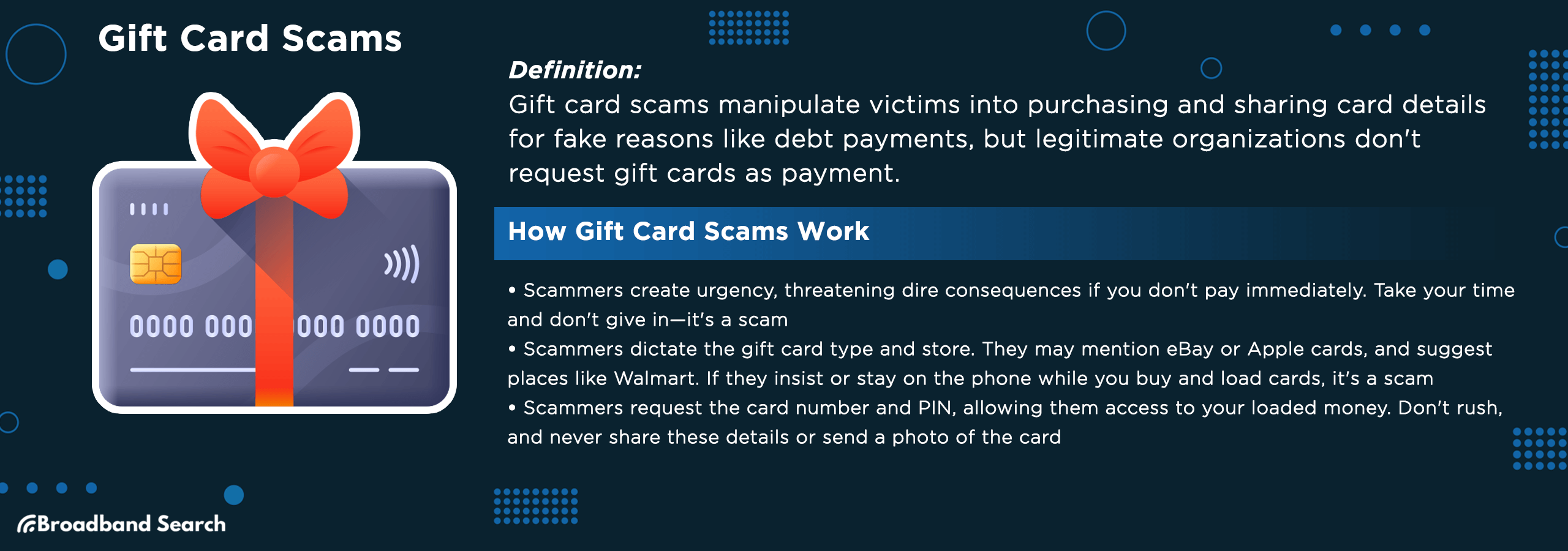
Gift card scams involve perpetrators tricking victims into buying gift cards and sharing the card details. Scammers often fabricate reasons like settling debts or helping a relative. They exploit the anonymity and versatility of gift cards. Consumers should be wary, as genuine entities never demand payments via gift cards.
Growing Concerns of Gift Card Scams
Gift cards are a popular holiday gift choice, but they also top a concerning list. The FTC's Consumer Protection Data Spotlight indicates that gift cards are the favored payment method for scammers, resulting in a staggering $148 million theft from consumers.
- Rising Reports and Losses: The frequency of gift card scam reports has been climbing since 2018, with corresponding financial losses also seeing an uptick. This trend underscores the increasing sophistication and prevalence of such frauds.
- Increased Individual Losses: The financial impact on individual victims has intensified over the years. In 2018, only 8% of victims reported losses exceeding $5,000. By the first nine months of 2021, this percentage had grown to 14%, with the median loss amount rising from $700 to a startling $1,000.
- Target Cards: A Scammer's Favorite: Among the various gift cards available, scammers exhibit a marked preference for Target cards, underscoring the need for heightened vigilance when dealing with requests involving these specific cards.
Malware and Ransomware Attacks
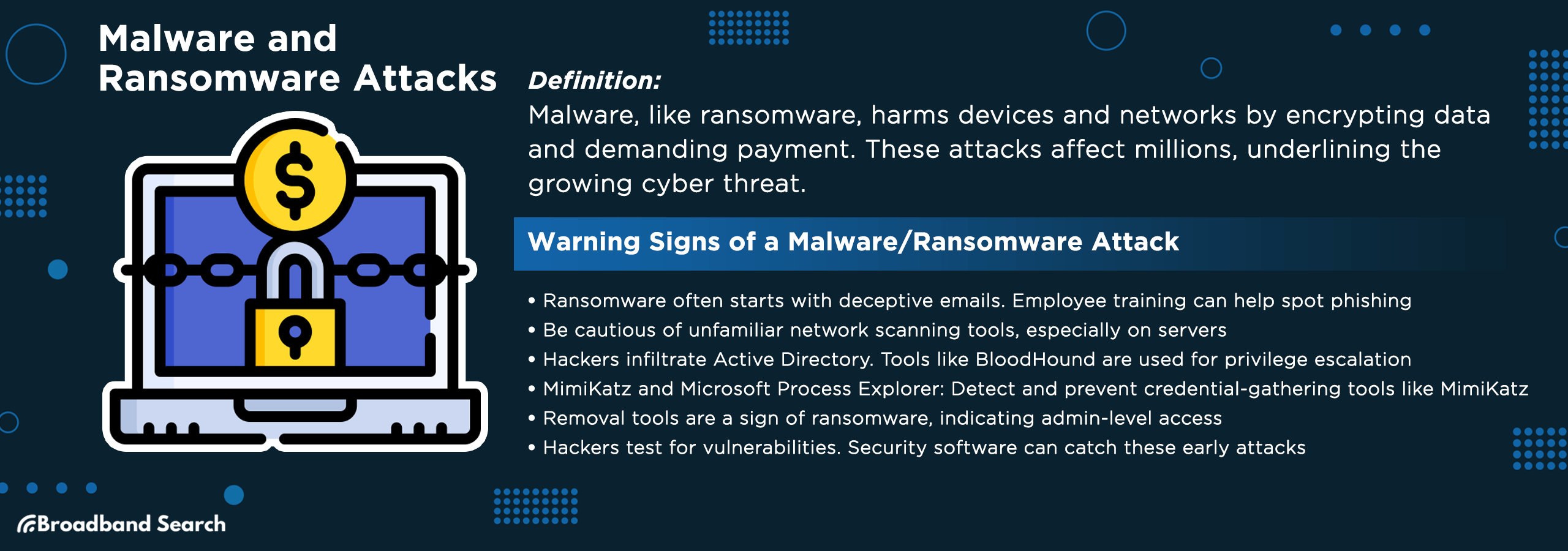
Malware is software designed to damage or exploit devices and networks. Ransomware, a malware subtype, encrypts victims' data, demanding payment for access restoration. The impact of these attacks can range from minor inconveniences to significant financial losses and disruption of services. In 2021, 15.45% of global internet users encountered at least one such attack, emphasizing the escalating cyber threat.
Global Yearly Percentage of Organizations Impacted by Ransomware
By 2023, ransomware attacks impacted a staggering 72% of global businesses, marking a significant rise from the past five years. This rate is the highest ever recorded. Notably, from 2018 onwards, over half of the surveyed businesses annually reported falling prey to ransomware incidents.
- 2023 - 72.7%
- 2022 - 71%
- 2021 - 68.5%
- 2020 - 62.4%
- 2019 - 56.1%
- 2018 - 55.1%
Top 5 Countries with the Highest Organizational Impact from Ransomware
Ransomware attacks have surged globally, with certain nations feeling the brunt more than others. The following list showcases the top five countries where organizations have been most significantly affected by these malicious cyber onslaughts:
- USA: 47%
- Italy: 8%
- Australia: 8%
- Brazil: 6%
- Germany: 6%
Dominant Ransomware Variants Globally in Q2 2023: Ranked by Market Presence
During the second quarter of 2023, both Blackcat and Black Basta dominated the ransomware scene, each capturing 15.5% of the global market share, making them the leading variants globally. Royal ransomware came in next, comprising about 10% of the attacks. Meanwhile, Lockbit 3.0 accounted for just over six percent of the total ransomware incidents detected across the world.
- BlackCat - 15.5%
- Black Basta - 15.5%
- Royal - 10.1%
- Lockbit 3.0 - 6.2%
- Akira - 5.4%
- Silent Ransom - 3.1%
- Cactus - 3.1%
Final Thoughts
Navigating the digital landscape requires a heightened sense of awareness. As we embrace the benefits of online platforms, it's equally crucial to recognize the inherent risks. Every online decision, from the data we disclose to the sites we frequent, demands careful scrutiny. Ensuring one's safety online isn't merely about preventing financial repercussions; it's also about safeguarding one's peace of mind.
Equally important is the role of the community in mitigating these threats. Spreading insights about online dangers and offering guidance can exponentially amplify our defenses against them. Engaging in discussions with friends, family, and colleagues about these concerns can create a ripple effect of awareness. By working collaboratively, we can fortify our defenses and make the digital world a more secure place for all.
FAQ
Are there specific age groups more targeted by online scammers?
Yes, certain age groups can be more vulnerable depending on the type of scam. For instance, older adults might be targeted for pension-related scams, while younger individuals might be more susceptible to social media or job-related scams.
Are there online scams related to COVID-19?
Absolutely. Scammers often exploit current events, and the COVID-19 pandemic has seen a rise in related scams. These can range from fake health products, counterfeit masks, to phishing emails pretending to be from health organizations.
Are mobile apps safe from online scams?
While many mobile apps, especially those on official stores like the App Store or Google Play, undergo security checks, no platform is entirely immune. It's essential to download apps from reputable sources, check reviews, and be wary of apps requesting unnecessary permissions.
How can I report an online scam?
Reporting mechanisms vary by country. Typically, you can report online scams to local law enforcement agencies, dedicated cybercrime units, or consumer protection agencies. Additionally, online platforms often have reporting tools for suspicious activity.
How prevalent are online scams during holiday seasons?
Online scams tend to surge during holiday seasons due to increased online shopping and charitable giving. Scammers take advantage of the festive spirit, offering fake deals, counterfeit products, or posing as charitable organizations. It's crucial to be extra cautious during these times.

